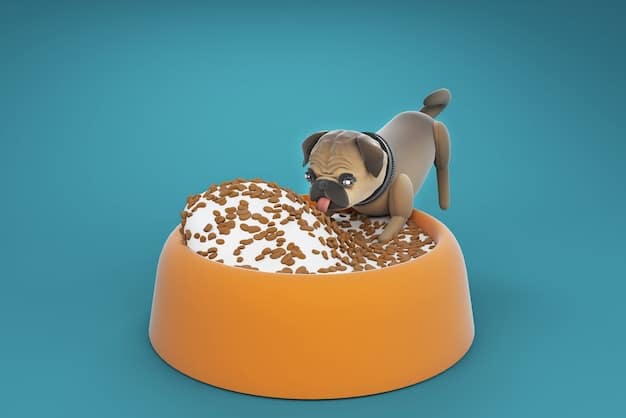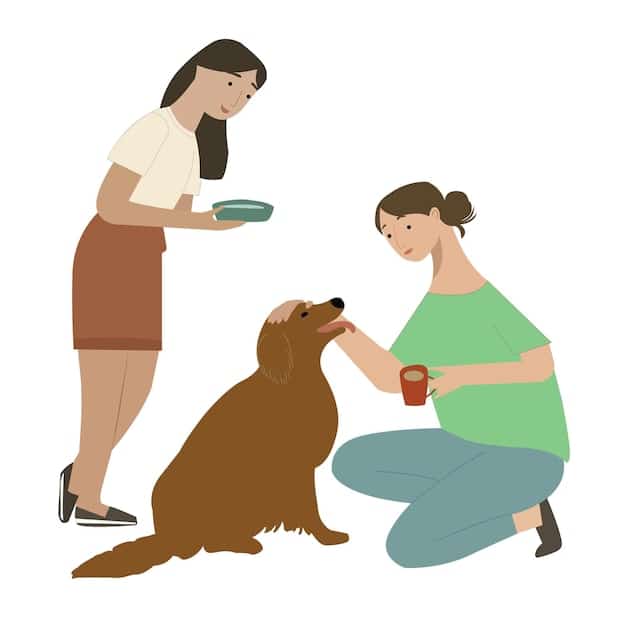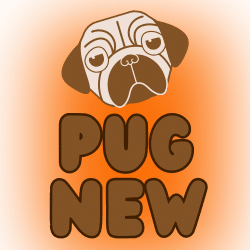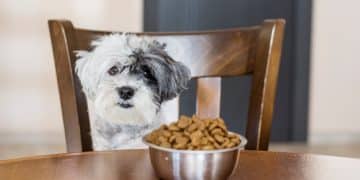Stop Food Aggression Now: Your Comprehensive Training Plan

Anúncios
Stop food aggression involves understanding the causes, recognizing the signs, and implementing a structured training plan to create a safer and more harmonious environment for both you and your dog.
Dealing with a dog that shows food aggression can be stressful and potentially dangerous. This comprehensive guide, titled Stop Food Aggression Now: A Comprehensive Training Plan for a Safer Home, provides you with the knowledge and steps necessary to address this behavior effectively, creating a more peaceful home environment.
Anúncios
Understanding Food Aggression in Dogs
Food aggression, also known as resource guarding, is a common behavioral issue in dogs where they become defensive or aggressive when someone approaches their food bowl or any high-value item. Recognizing the root causes and identifying the early signs are crucial first steps in addressing this behavior.
This behavior isn’t simply about being greedy; it stems from deep-seated instincts related to survival and competition.
Anúncios
Why Do Dogs Develop Food Aggression?
Several factors can contribute to the development of food aggression in dogs. Understanding these can help you tailor your approach to addressing the issue effectively.
- Genetics: Some dogs may be genetically predisposed to resource guarding due to their breed or lineage.
- Early Experiences: Puppies who experienced food scarcity or competition in their early lives might develop a stronger tendency to guard their food.
- Learned Behavior: A dog might learn to guard its food if it feels threatened or has had its food taken away in the past.
- Insecurity: Dogs that lack confidence or feel insecure may exhibit food aggression as a way to control their environment.
Recognizing these underlying causes can give you valuable insight into why your dog is behaving this way. This understanding is essential for creating a training plan that addresses the root of the problem.

Recognizing the Signs of Food Aggression
Early detection of food aggression is key to preventing escalation. Here are some common signs to watch out for:
- Stiffening: The dog becomes rigid or tense when someone approaches its food.
- Growling: A low, guttural sound indicating the dog’s displeasure.
- Snapping: A quick, aggressive bite towards the approaching person or animal.
- Showing Teeth: Exposing the teeth as a warning sign.
- Guarding: Placing the body over the food bowl or carrying the food away.
By identifying these signs early, you can intervene before the behavior becomes more ingrained. Be observant of your dog’s body language and reactions during meal times.
Food aggression is not an insurmountable problem. With understanding, patience, and a structured training plan, you can help your dog overcome this behavior and create a safer environment in your home.
Setting Up a Safe Feeding Environment
Creating a safe feeding environment is crucial for managing and reducing food aggression. This involves managing their space, controlling interactions, and understanding the role of the environment in shaping your dog’s behavior.
Consider the feeding location, the presence of other pets or family members, and how these factors can influence your dog’s anxiety around food.
Choosing the Right Feeding Location
The location where you feed your dog can significantly impact their anxiety levels. Select a quiet, low-traffic area where they feel secure and undisturbed.
Avoid feeding your dog in high-traffic areas, such as hallways or near doorways, as these can create a sense of vulnerability. A corner of a room or a designated feeding station can help your dog feel more secure.
Managing Other Pets and Family Members
If you have multiple pets, ensure they are fed separately and far enough apart to prevent competition or conflict. Supervise children closely during feeding times, and teach them to respect the dog’s space.
Train other pets to stay away from the designated feeding zone. Ensure that children understand not to approach the dog while it’s eating and never to attempt to take away its food.
Creating a Positive Association with Approach
One of the first steps in addressing food aggression is creating a positive association with people approaching the food bowl. Begin by approaching the bowl while the dog is eating and tossing in a high-value treat.
- Start from a Distance: Initially, approach from a distance where the dog doesn’t react negatively.
- Use High-Value Treats: Choose treats that your dog loves, such as small pieces of chicken or cheese.
- Gradually Decrease the Distance: Over time, gradually decrease the distance as your dog becomes more comfortable.
This helps the dog associate your presence with positive experiences, reducing their anxiety and defensiveness.
A safe and controlled feeding environment is fundamental to managing food aggression effectively. By carefully considering the location, managing interactions, and fostering positive associations, you set the stage for successful training and a more harmonious home.
Implementing a Gradual Training Plan
A gradual training plan is essential to help your canine companion overcome food aggression. This involves introducing incremental steps and exercises that build trust and reduce anxiety around food.
Consistency and patience are key. It’s important to progress at your dog’s pace, ensuring they remain comfortable and don’t exhibit signs of increased aggression.
Desensitization and Counter-Conditioning Techniques
These techniques are at the heart of addressing food aggression. Desensitization involves gradually exposing the dog to the trigger (your approach) at a low intensity, while counter-conditioning changes the dog’s emotional response to the trigger from negative to positive.
Start by approaching the dog’s bowl from a distance while they are eating, and then toss a tasty treat into the bowl. Over time, gradually decrease the distance as the dog becomes more comfortable.
Hand Feeding Exercises
Hand feeding can build trust and demonstrate that your hands bring good things, not threats. Start by offering a few pieces of food from your hand during each meal.
- Use an Open Palm: Present the food in an open palm to appear less threatening.
- Speak Calmly: Use a soothing voice to reassure the dog.
- Avoid Direct Eye Contact: Direct eye contact can be perceived as a challenge.
Gradually transition to feeding the entire meal by hand, reinforcing the idea that you are the provider of good things.

The “Trade Up” Method
This technique involves approaching the dog’s food bowl and offering something even more appealing in exchange for their food. This teaches the dog that your presence can be rewarding rather than threatening.
For example, offer a piece of chicken or cheese in exchange for the food in their bowl. As the dog gets more comfortable, you can gradually increase the challenge by taking the bowl and then returning it with even more treats.
Positive reinforcement is a crucial element of the trade-up method. Here’s how to implement it effectively:
- Timing is Key: Offer the “trade” at the right moment, before the dog becomes too anxious or defensive.
- Use High-Value Rewards: Ensure the reward is something the dog truly values, such as a favorite toy or a special treat.
- Praise and Reassurance: Verbally praise the dog and offer reassurance when they cooperate.
These progressive steps are designed to reshape the dog’s perception of your presence around their food bowl. By replacing fear with trust, you’re paving the way for a more balanced and enjoyable relationship.
A gentle and patient approach, combined with consistency, should reduce food aggression over time. Remember to celebrate even small victories and adjust the training plan as needed based on your dog’s progress.
Dealing with Setbacks and Challenges
When addressing food aggression in dogs, setbacks and challenges are inevitable. Anticipating these issues and having strategies to manage them effectively is vital for maintaining progress.
Even with the most structured training plan, there will be times when your dog reverts to old behaviors. Understanding how to handle these situations can prevent frustration and ensure continued progress.
Recognizing and Responding to Increased Aggression
If your dog shows signs of increased aggression during training, it’s important to stop immediately and reassess. This could involve increasing the distance, using higher value treats, or slowing down the training process.
Do not punish the dog for showing aggression, as this can exacerbate the problem. Instead, calmly remove yourself from the situation and try again later with a modified approach.
Adjusting the Training Plan As Needed
A successful training plan is one that is flexible and adaptable to the dog’s needs and progress. Regularly evaluate the dog’s behavior and adjust the training steps accordingly. If the dog is struggling, break down the steps into smaller, more manageable increments.
Here’s how to tailor your approach for sustained improvement:
- Keep a Training Journal: Record the dog’s reactions and progress after each session.
- Seek Professional Guidance: Consult a certified dog trainer or behaviorist for advice and support.
- Be Observant: Pay close attention to the dog’s body language and cues.
Remember, every dog is unique, so what works for one dog may not work for another.
Seeking Professional Help
If you are struggling to make progress on your own or if the food aggression is severe, don’t hesitate to seek professional help. A certified dog trainer or behaviorist can provide personalized guidance and support. They can assess the dog’s behavior, identify underlying issues, and develop a tailored training plan.
Dealing with setbacks and challenges in food aggression training requires patience, flexibility, and a willingness to adapt. Keep your expectations realistic, celebrate small victories, and seek professional guidance when needed.
Remember, progress is not always linear, and consistency is key. Stay positive, and continue to provide a safe and supportive environment for your dog.
Preventing Food Aggression in Puppies
Preventing food aggression in puppies starts with early socialization and positive reinforcement. By fostering a healthy relationship around food from the beginning, you can minimize the risk of this behavior developing.
Creating positive associations with food is key during puppyhood, as this sets the foundation for a lifetime of healthy eating habits.
Early Socialization and Positive Reinforcement
Expose your puppy to a variety of people and situations around meal times to help them become comfortable with others being present. This can include family members, friends, and even other pets.
Steps to promoting positive interactions during meal times throughout your puppy’s development:
- Gentle Handling: Get your puppy used to being touched and petted while eating.
- Hand Feeding: Regularly offer small portions of food from your hand with a soothing voice.
- Positive Reinforcement: Reward relaxed behavior around food with praise and treats.
The goal is to create a positive association with people approaching the food bowl, rather than a sense of threat.
Teaching “Leave It” and “Drop It” Commands
These commands are essential for preventing resource guarding. Teach your puppy to willingly give up toys or food items on command.
Start by offering a trade: present a high-value treat in exchange for the item the puppy has. Then, gradually introduce the verbal cue “leave it” or “drop it” as the puppy releases the item.
Avoiding Scarcity Mentality
Ensure your puppy always has access to enough food. Avoid creating competition by feeding multiple puppies separately and providing ample resources.
Never take food away as punishment or to assert dominance. This can create anxiety and increase the likelihood of resource guarding.
Preventing food aggression in puppies is about creating a positive, safe, and predictable environment around meal times. By using early socialization, positive reinforcement, and consistent training, you can help your puppy develop a healthy relationship with food and minimize the risk of developing aggressive behaviors.
Remember, consistency is key. Set clear expectations for your puppy and consistently reinforce positive behaviors around food.
Long-Term Management and Maintenance
Long-term management and maintenance are crucial for preventing food aggression from recurring. By consistently reinforcing positive behaviors and maintaining a proactive approach, you can ensure your dog remains comfortable and secure around food.
Even after successful training, it’s important to continue practicing the techniques and strategies that helped your dog overcome their food aggression. Consistency is key to maintaining the progress you’ve made.
Continuing Reinforcement of Positive Behaviors
Regularly practice hand-feeding and the “trade up” method, even after the dog has shown improvement. This will reinforce the positive associations with people approaching the food bowl.
Continue to reward relaxed and calm behavior around food with praise and treats. This will help the dog maintain a positive emotional state during meal times.
Maintaining Consistency in Feeding Routines
Stick to a consistent feeding schedule and location. This will help the dog feel secure and predictable about meal times.
Ensure that other pets and family members continue to respect the dog’s space during feeding times. Avoid any situations that could trigger food aggression, such as approaching the dog while it’s eating or attempting to take away their food.
Monitoring for Relapses and Addressing Them Promptly
Be vigilant for any signs of relapse, such as stiffening, growling, or guarding. If you notice these behaviors, increase the distance during feeding times and revisit the training steps as needed.
Don’t punish the dog for relapsing. Instead, calmly address the issue and provide reassurance.
Long-term management and maintenance involve consistent reinforcement of positive behaviors, maintaining a structured feeding routine, and promptly addressing any signs of relapse. By staying proactive and vigilant, you can help your dog maintain a healthy relationship with food and ensure a peaceful environment.
Remember, ongoing support and consistency are essential for maintaining a positive relationship between you and your dog.
| Key Point | Brief Description |
|---|---|
| 🐕 Understanding Food Aggression | Recognize causes and signs to address the behavior effectively. |
| 🥣 Safe Feeding Environment | Create a secure space and positive associations with approach. |
| 🍖 Gradual Training Plan | Use desensitization, hand feeding, and the “trade up” method. |
| 🐾 Preventing Food Aggression | Socialize puppies early and reinforce positive behaviors around food. |
Frequently Asked Questions
▼
Food aggression, or resource guarding, is when a dog becomes defensive or aggressive around their food or high-value items, stemming from instinctual survival and competition.
▼
Choose a quiet, low-traffic area, manage interactions by feeding multiple pets separately, and ensure children respect the dog’s space during meal times.
▼
Desensitization and counter-conditioning, hand feeding, and the “trade up” method are highly effective to build trust and change a dog’s emotional response around food.
▼
Stop the training immediately, increase the distance, use higher value treats, or slow down the training process. Avoid punishment and seek professional help if needed.
▼
Early socialization, positive reinforcement around meal times, and teaching “leave it” and “drop it” commands from a young age are essential preventative measures.
Conclusion
Overcoming food aggression requires dedication, patience, and a multifaceted approach. By understanding the underlying causes, setting up a safe feeding environment, and consistently implementing a gradual training plan, you can help your dog develop a healthier relationship with food and create a safer, more harmonious home. Remember, consistency and positive reinforcement are key to long-term success.






